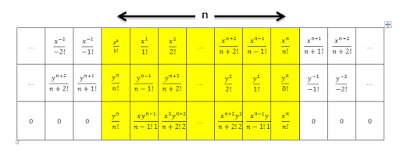Its clear that the devirative of $e^x$ equal itself for the integer order differentiation.
So does it means that it is allowed to equal itself for the half order as well?
Have you asked yourself if there is a function equal itself only every $even$ order or every $nth$ order throughout its multiples?
See the behavior of the following functions where $n \in \Bbb Z$
1) $D^{n}_x( e^x)=e^x $ (neutral function of integer-order Diffrentiation)
2) $D^{2n}_x\left(\frac{e^x+e^{-x}}{2}\right )=\frac{e^x+e^{-x}}{2}$ (neutral function of only even-order Diffrentiation)
3) $D^{3n}_x\left(\frac {e^x+e^{\omega x}+e^{\omega^2 x}}{3}\right)=\frac {e^x+e^{\omega x}+e^{\omega^2 x}}{3}$ where $\omega=e^{\frac{\pi i}{3}}$ (neutral function of only multiples-of-3-order Diffrentiation)
4) $D^{4n}_x\left(\frac {e^x+e^{-x}+e^{ix}+e^{-ix}}{4}\right)=\frac {e^x+e^{-x}+e^{ix}+e^{-ix}}{4}$ (neutral function of only multiples-of-4-order Diffrentiation)
and so on...
These belong to exponential k step $\sum_{k \in \Bbb Z}\frac{x^{nk}}{(nk)!}$ any every function of them can not equal itself with an order out of its $nth$ order and its multiples.
(
Exponential k step has a formula for generating any k step , $\sum_{k \in \Bbb Z}\frac{x^{nk}}{(nk)!}=\frac1k\sum_{j=1}^{k}e^{r^j_k x}$
where $r_k=e^{\frac{2\pi i}{k}}$)
Now let us rearrange the functions in other patern.
In the following steps I will use Mittag-Leffler function instead of k step sum but with little change as:
$$E_{\alpha}(x^{\alpha})=\sum_{k \in \Bbb Z}\frac{x^{\alpha k}}{(\alpha k)!} , \alpha >0 \tag 1$$
1) For $\alpha=1$ , $E_{1}(x)=e^x$
2) For $\alpha =2$ , $E_{2}(x^2)=\frac12(e^x+e^{-x})$
3) For $\alpha =4$ , $E_{4}(x^4)=\frac14(e^x+e^{-x}+e^{ix}+e^{-ix})$
4) For $\alpha =8$ , $E_{8}(x^8)=\frac18(e^x+e^{-x}+e^{ix}+e^{-ix}+e^{(i+1)x}+e^{(i-1)x}+e^{(-i+1)x}+e^{(-i-1)x})$
and so on every $2^n$ itration
We can obseve two relations
$$E_{2\alpha}(x^{2\alpha})=\frac12\left(E_{\alpha}(x^{\alpha})+E_{\alpha}\left((-1)^{\frac1{\alpha}}x^{\alpha}\right)\right) \tag 2$$
and
$$E_{\alpha}(x^{\alpha})=E_{2\alpha}(x^{2\alpha})+D_x^{\alpha}\left(E_{2\alpha}(x^{2\alpha})\right) \tag 3$$
For example:
$E_1(x)=E_2(x^2)+D^1_x(E_2(x^2))$
$=\frac12(e^x+e^{-x})+D^1_x\left(\frac12(e^x+e^{-x})\right)$
$=\frac12(e^x+e^{-x})+\frac12(e^x-e^{-x})=e^x$
Now if we let $\alpha = \frac12$ then
$E_{1/2}(x^{1/2})=E_1(x)+D_x^{1/2}(E_1(x))$
$=e^x+D_x^{1/2}(e^x)$
From eq(1) we have $$E_{1/2}(x^{1/2})=\sum_{k \in \Bbb Z}\frac{x^{\frac12 k}}{(\frac12 k)!}=\cdots +\frac{x^{-1}}{-1!}+\frac{x^{-1/2}}{-1/2!}+\frac{x^0}{0!}+\frac{x^{1/2}}{1/2!}+\frac{x^1}{1!}+\frac{x^{3/2}}{3/2!}+\frac{x^2}{2!}+\frac{x^{5/2}}{5/2!}+\cdots$$
Then
$$e^x+D_x^{1/2}(e^x)=\left(\cdots +\frac{x^{-1}}{-1!}+\frac{x^0}{0!}+\frac{x}{1!}+\frac{x^2}{2!}+\cdots\right)+\left(\cdots +\frac{x^{-1/2}}{-1/2!}+\frac{x^{1/2}}{1/2!}+\frac{x^{3/2}}{3/2!}+\frac{x^{5/2}}{5/2!}+\cdots\right)$$
Therefore
$$D_x^{1/2}(e^x)=\cdots +\frac{x^{-5/2}}{-5/2!}+\frac{x^{-3/2}}{-3/2!}+\frac{x^{-1/2}}{-1/2!}+\frac{x^{1/2}}{1/2!}+\frac{x^{3/2}}{3/2!}+\frac{x^{5/2}}{5/2!}+\cdots$$
Unfortunately the half-order differentiation of $e^x$ is undefined by this series expansion.
AN OTHER PROOF
Let us assume that $D_x^{1/2}(e^{ax})=a^{1/2}e^{ax}$ that means:
$$D_x^{1/2}\left(\lim_{n \to \infty}(1+\frac1n)^{n(ax)}\right)=a^{1/2}\left(\lim_{n \to \infty}(1+\frac1n)^{n(ax)}\right)$$
And also by exponential property it can be written as:
$$D_x^{1/2}\left(\lim_{n \to \infty}(1+\frac anx)^{n}\right)=a^{1/2}\left(\lim_{n \to \infty}(1+\frac anx)^{n}\right)$$
Now the equation is under power role which seems to be ok for any integer-order differentioation.
Because $n$ is constant so it can be any positive real vlaue, and we expect the same result for any value of $n$.
Then for the first test $(n=1)$,
$$D_x^{1/2}\left((1+ ax)^{(1)}\right)=\frac{a^{1/2}}{\Gamma(3/2)}(1+ax)^{(\frac12)}$$
But if we solve it directly we get,
$$D_x^{1/2}\left(1+ ax\right)=\frac{x^{-1/2}}{\Gamma(1/2)}+a\frac{x^{1/2}}{\Gamma(3/2)}$$
And we can simply see that,
$$\frac{a^{1/2}}{\Gamma(3/2)}(1+ax)^{(\frac12)} \neq \frac{x^{-1/2}}{\Gamma(1/2)}+a\frac{x^{1/2}}{\Gamma(3/2)}$$
Hence the first test $"n=1"$ has failed.
FINALLY
Nevertheless there is a relation which says
$$D_x^{\alpha}(e^x)=e^x \cdot D_x^{\alpha}(e^x)|_{x=0}$$
Which I will prove it in one of the next posts (If God wills).
